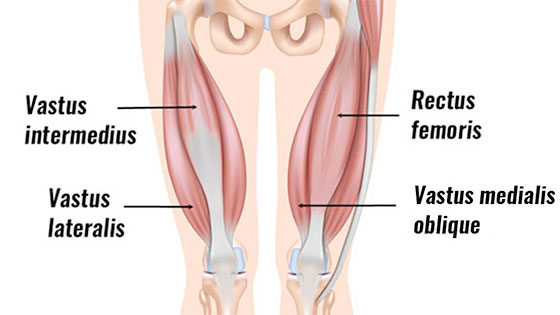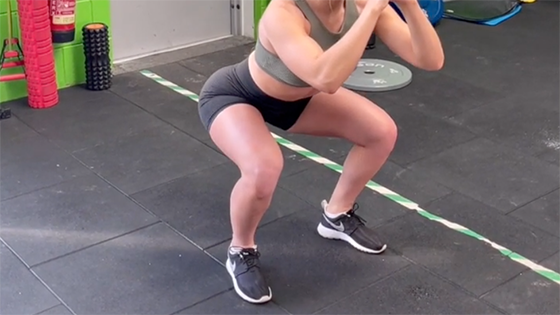VMO KNEE STRENGTHENING REHABILITATION
A Step-by-Step Rehab Program by Elite Level Sports Physiotherapist Paul Tanner.

What is the vastus medialis oblique (VMO) muscle?
The vastus medialis oblique (VMO) is part of the quadriceps on the inner front thigh above the knee. Strengthening it helps control knee extension and patella tracking, making it important for preventing and rehabilitating knee injuries like anterior knee pain and patellofemoral pain.
Strengthen My VMO
Our step-by-step rehabilitation app is designed to strengthen the vastus medialis oblique (VMO)
Why Structured Rehabilitation Is Essential
VMO strengthening rehabilitation targets weakness in the vastus medialis oblique, a key muscle for knee stability. Deficits here often contribute to pain, poor control, and recurrent injuries. Our program restores VMO activation and strength through progressive, evidence-based exercises, with recovery monitored at every stage.

Is it suitable for me?
This program is suitable for anyone wishing to strengthen the VMO muscle. In particular, for anterior knee pain or patellofemoral pain syndrome. Whether it is a recent injury or you have suffered for some time we take you step by step from injury to full fitness. Ideal for both beginner and elite-level athletes.
To access the full program, view our subscription plans.
Program Author
Paul Tanner
Paul is Head of Medical at Bristol City FC and has previously held senior roles at Millwall Football Club, providing comprehensive match-day and training-ground physiotherapy and medical support.
His career also includes positions as First Team Physiotherapist at Norwich City FC and Senior Physiotherapist with London Wasps Rugby, giving him extensive experience at the highest levels of professional sport.

How does it work?
The program consists of 3 progressive phases. You only progress to the next phase once you’ve met the specific exit criteria, ensuring your recovery is both safe and effective.
Elite-level sports physiotherapist Paul Tanner introduces each phase through guided videos. The app provides daily instructions (“Today’s Tasks”) and tracks your progress, which can be reviewed later by you, your coach, or your physio. This program doesn’t just aim to heal your injury—it’s built to help you return stronger, more resilient, and ready for long-term performance.
Phase 1
This is the introductory phase and lasts from 1 to 2 weeks. Work through the exercises each day and move on when you reach the Exit Criteria.
Phase 2
Phase 2 moves on from basic isometric exercises and focuses on strengthening exercises that involve movement.
Phase 3
This is the advanced strengthening phase and builds on the first two phases.
What’s included?
The program includes the following elements:
Treatment & healing
This covers how and when to apply treatment such as cold therapy & compression, heat, massage, and taping.
Exercises
Over 60 different exercises with video demonstrations covering mobility & stretching, activation, strengthening, motion control/proprioception, and functional or activity-specific exercises and running progressions.
Priority support
If you have any questions about the program or your progress, then use in-app support to get in touch with our qualified sports therapist for advice.
Got Questions? We’ve got answers.
How long does it take to strengthen the VMO?
You can expect strength improvements within 4–6 weeks of consistent exercise. Building more noticeable muscle size may take 8–12 weeks or longer. Progress depends on the quality of training, recovery, and adherence to a structured rehabilitation program.
What is the best way to strengthen the VMO?
Targeted exercises include mini-squats, straight leg raises, step-downs, and terminal knee extensions. These are most effective when combined with hip and core strengthening to support overall knee stability. The SportsRehab app provides a progressive rehabilitation plan with daily tasks and physiotherapist-led videos to guide safe progression.
Why is the VMO important?
The VMO is the inner portion of the quadriceps muscle group. It plays a key role in stabilising the kneecap and controlling its movement during walking, running, and squatting. Weakness in the VMO is linked to patellofemoral pain and reduced knee stability.
Does VMO strengthening help knee pain?
Yes. Strengthening the VMO improves kneecap tracking and can reduce pain in conditions such as patellofemoral pain syndrome, jumper’s knee, and after ACL injury. When combined with hip and glute work, it forms an essential part of long-term knee rehabilitation.
Can you isolate the VMO during exercise?
It is difficult to fully isolate the VMO, but certain exercises and positions emphasise it more. Training with the knee slightly bent (20–30 degrees) increases activation. A complete rehabilitation program balances VMO-focused exercises with strengthening of the quadriceps, hips, and glutes.
Visit our full FAQ page for detailed answers about the programs and using sportsrehab.app

